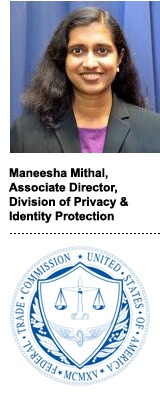 When Maneesha Mithal first joined the Federal Trade Commission’s Bureau of Consumer Protection in 1999 – eight years before the first iPhone came out – the big issues of the day were how to regulate ecommerce and handle spam.
When Maneesha Mithal first joined the Federal Trade Commission’s Bureau of Consumer Protection in 1999 – eight years before the first iPhone came out – the big issues of the day were how to regulate ecommerce and handle spam.
The threat vectors have changed.
The FTC’s top three priorities in 2017 will be Internet of Things security, health data and data security overall, said Mithal, who serves as associate director of the commission’s Division of Privacy and Identity Protection.
Those are all-important topics regardless of politics or which party sits at the helm.
“We’ve been working on privacy issues through Democratic administrations and Republican administrations,” she said. “While particular priorities may evolve, we’re in this space to stay.”
Mithal has been with the FTC through three presidencies – Clinton, Bush the younger and Obama – and is likely to stay in her post despite President-Elect Trump’s ongoing federal shakeups.
AdExchanger caught up with Mithal in Washington, DC.
AdExchanger: What does it mean to have a privacy policy in the Internet of Things era?
MANEESHA MITHAL: We don’t think disclosures should be buried in privacy policies. They should be out in the user interface. But with the IoT we often hear, “Well, there is no real user interface.”
In our IoT report, we point to the innovations that some companies have been making in order to provide disclosures for consumers. You need to look at touchpoints. Are there disclosures that can be put in setup wizards? Are there video tutorials that could be put online? Is there training that can be done when you buy a product? Are there icons or dashboards that companies can use? Those are all things to consider.
How does the FTC keep pace with technical innovation?
First, we hire tech savvy people. A lot of the attorneys we’ve hired in the last few years are tech savvy and we’ve created new positions for technologists. We also have a chief technology officer.
Second, we have OTech [the FTC Office of Technology Research and Investigation], which has done original research on smart TVs, drones, ransomware and changing demographics. It’s a useful way for us to gain knowledge about the products and services out there.
And third, we try to build ties with the academic and tech communities outside the FTC. We host an annual PrivacyCon event and we’re always soliciting research from tech researchers as well as encouraging researchers to disclose security vulnerabilities they find to us.
Consumers aren’t always clued into the vast ecosystem of third parties collecting, selling and sharing their data online. How do you educate consumers about the data collection potential of the IoT?
That is one of the big issues we’re facing. It’s a challenge for consumers to understand the multiplicity of players in the ecosystem. If you look at our data broker report, we talk about the fact that data can take so many hops. You might provide your data to a retailer, and the retailer might share it with hundreds of data brokers. We’ve called for greater transparency for consumer-facing entities.
It’s a similar concept in the IoT. Consumer-facing companies have a particular responsibility because they’re the ones consumers can go to if they have a problem and they’re the ones whose brand will be affected if something happens downstream that the consumer finds inappropriate.
There’s an onus on the consumer-facing entity to do some due diligence on anybody they’re sharing data with. It’s not a strict liability, but we do look to see if the company took reasonable steps to ensure that the downstream players were good players.
The Internet of Things is a good example of innovation getting ahead of regulation. A smart thermostat knows what temperature someone’s house is, which is a banal detail, but it can also know when someone isn’t home. Where does the FTC draw the line between what is considered sensitive data and what is not?
There are four categories of information that we deem sensitive: health, financial, children’s information and precise geolocation. We’ve also said that there is a fifth category, which is content of communications; for example, the contents of emails. Beyond that, our framework has been that if what you’re doing with data is inconsistent with consumer expectations, you need to disclose that and explain to consumers how you’re using it.
The FTC is big on education and hosting forums for discussion on subjects like cross-device, disclosures and smart TVs. What prompts the FTC to host one of these things?
There’s no hard and fast rule, but anything that’s new, ubiquitous and raises new data issues is something that’s likely to be on our radar screen.
These workshops inform us as we work on our investigations and on consumer and business education going forward. Sometimes at the end of the workshop, we will start developing a report with a summary of the workshop for people that couldn’t be there and some sort of best practice guidance for companies.
It’s been awhile, but is the FTC planning to issue a report based on the cross-device workshop in Nov. 2015?
We are developing reports on the Cross-Device Tracking workshop. I can say it’s coming soon.
This post was syndicated from Ad Exchanger.

More Stories
Dismantling Google Will Not Fix the Adtech Ecosystem
Meta’s Threads Begins Global Ad Rollout Within Its Feed
Adtech Firm Criteo Is Pitching Hundreds of Retailers on a New Video Ad